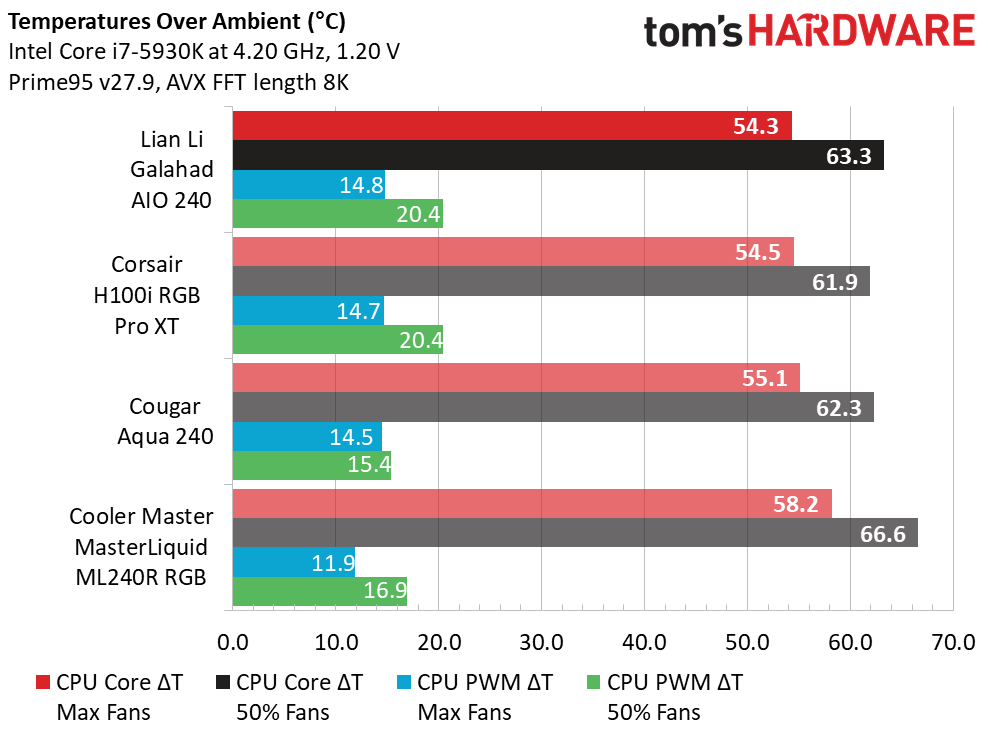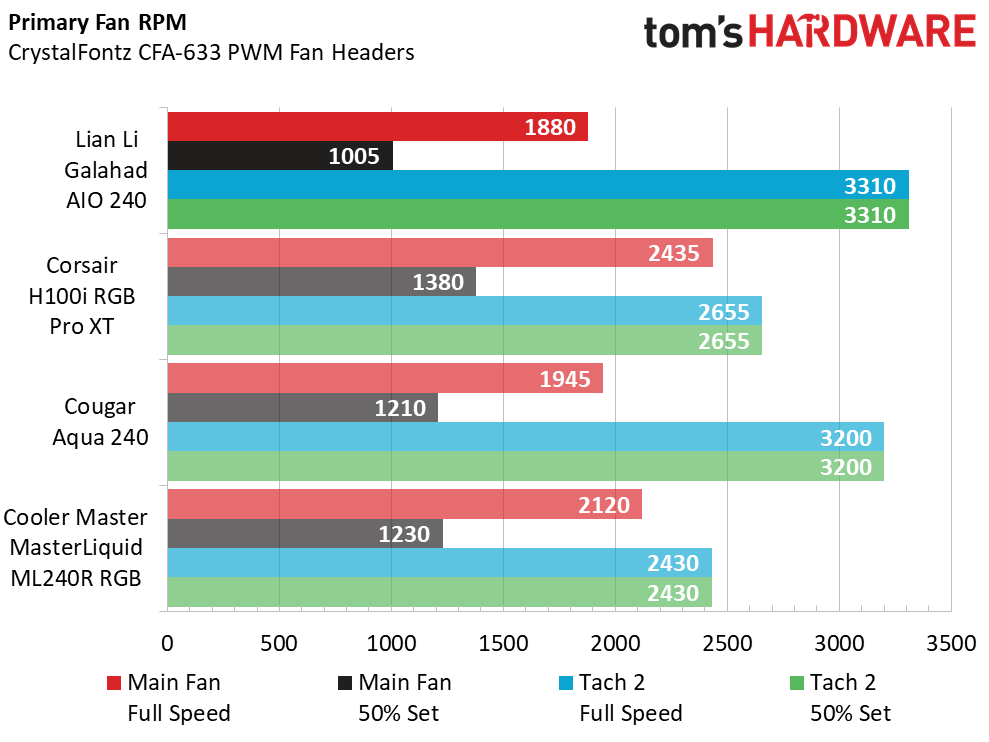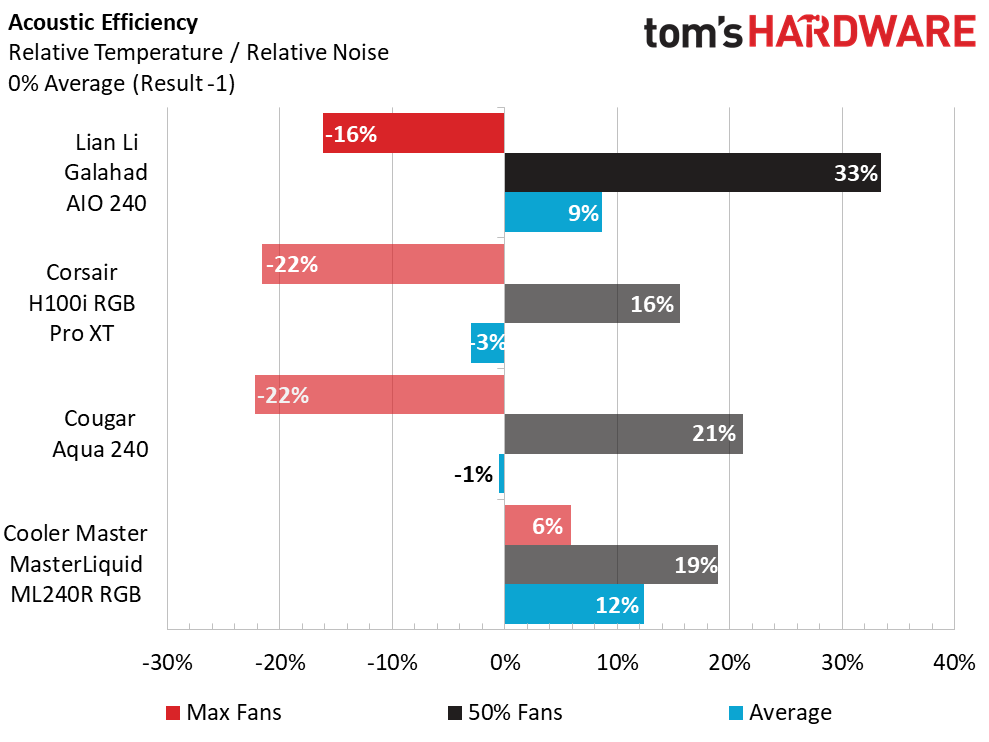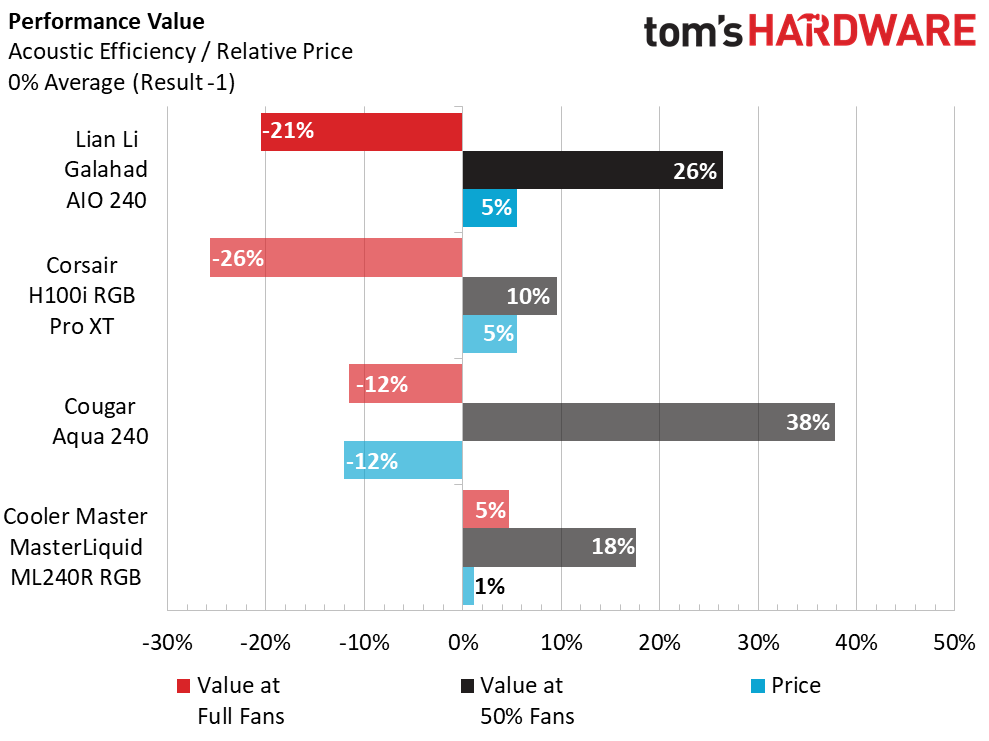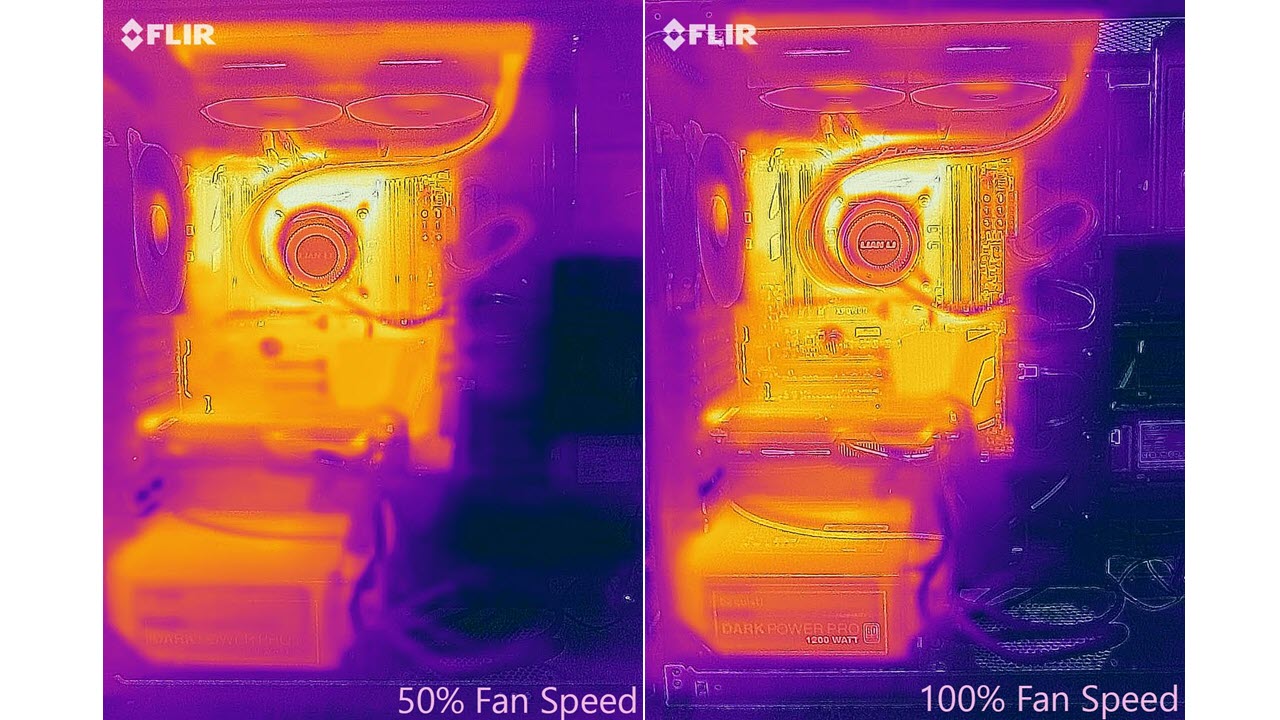Why you can trust Tom's Hardware
We will utilize data collected during testing of the Lian Li Galahad AIO 240 to compare with others in the 240mm AIO segment. Our test system consists of an i7-5930K clocked to 4.2Ghz at 1.20v on our MSI X99S XPower AC motherboard, paired with 16GB of Crucial Ballistix Sport DDR4-2400 memory. Power comes the way of a be quiet! Dark Power Pro 1200w power supply inside a Corsair Graphite 760T chassis.
Note that we are in the process of updating our cooling rig to a much more modern setup. But for now, the overclocked 140W processor still does a good job of taxing modern coolers.
We’ll take a closer look at the Lian Li Galahad AIO 240 compared with the Corsair H100i RGB Pro XT, Cougar Aqua 240 and Cooler Master MasterLiquid ML240R RGB.
While all coolers turn in very competitive thermal load results, the Lian Li Galahad AIO 240 nudges past the Corsair H100i RGB Pro XT and Cougar Aqua 240 at 100% fan speed. Differences of only a few degrees Celsius show just how closely our peer group performs.
Of all the coolers in the test group, the fans on the Galahad AIO 240 are the slowest turning. The Galahad’s 120mm fans are rated up to 1900 RPM by Lian Li, meaning they nearly reach their rated threshold.
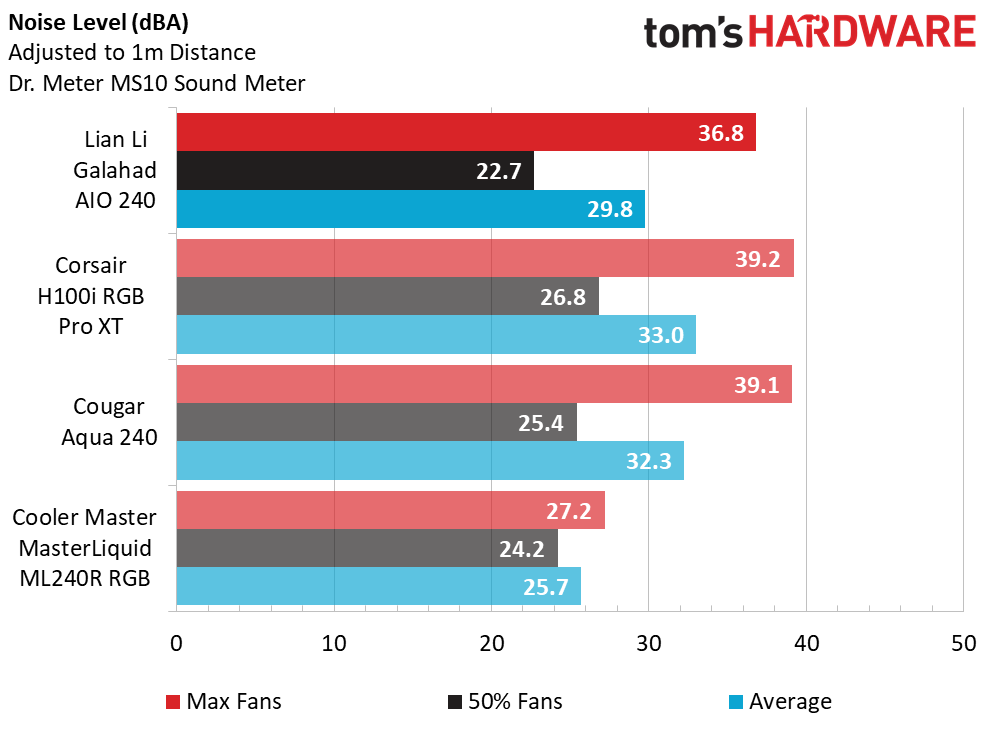
Typical of AIO coolers, fan noise is more noticeable as fans reach 100% utilization. This makes fan curves very important to system builders who value AIO cooling performance but also appreciate a system that remains quiet until more cooling is needed.
Our acoustic efficiency chart provides a look at how well a cooler performs as a product of how noisy it is in the process of doing that work. The lower noise levels of the Cooler Master ML240R RGB creates a low overall baseline for the testing group, making it difficult for the coolers to pull away with better thermal performance values, but noisier fan measurements.
The Lian Li Galahad AIO 240 releases right at $120, making it just slightly higher in price than the group average. With most of the coolers in the group performing very similar to one another, the slightest differences in values can begin to isolate the graph data in a very pronounced way. But as this is launch pricing from Lian Li, a sale price that drops it down a few dollars in the coming months would make the cooler look much better here.
Get Tom's Hardware's best news and in-depth reviews, straight to your inbox.
Thermal imaging from our FLIR ONE Pro shows some distinct thermal soak of the Lian Li Galahad AIO 240 at 50% fan speed. Notable temperature differences along the length of the Galahad’s radiator and coolant tubing can be easily seen between the 50%/100% images.
Bottom Line
With the release of its new Galahad AIO coolers, Lian Li has positioned itse in a strong position with its new AIO offerings, even in the very competitive liquid cooling market we have today. With great thermal performance at 100% fan speed, the Galahad AIO 240 is a top-tier performer while still remaining fairly affordable. The lack of a software UI control suite is a debatable downside, but system builders can easily make use of a simple fan BIOS fan curve while avoiding the bloat of multiple startup applications.
- 1
- 2
Current page: Comparison Coolers, Testing Results and Conclusion
Prev Page Features and Specifications
Garrett Carver is a contributor for Tom’s Hardware, primarily covering thermal compound comparisons and CPU cooling reviews; both air and liquid, including multiple variations of each.
-
cma6 Excellent review from Garrett Carver. However, he needs to address this question: Does this cooler support AMD Ryzen Threadripper 3 3970X?Reply
"The Lian Li Galahad AIO 240 arrives ready to support the majority of current CPU sockets." While HSF coolers all come with extended base plates to ensure maximum contact with the CPU's IHS, most AIO coolers haven’t made that step yet, and still use circular cold plates that leave the edges of the IHS exposed. AIO coolers available for Threadripper CPUs therefore aren’t cooling as efficiently as they could, allowing the HSF coolers to match (and even exceed) their performance. -
g-unit1111 Looks like a decent cooler. But for a 280mm cooler there's no way I would choose that over a Corsair or NZXT.Reply -
Makaveli Replycma6 said:Excellent review from Garrett Carver. However, he needs to address this question: Does this cooler support AMD Ryzen Threadripper 3 3970X?
"The Lian Li Galahad AIO 240 arrives ready to support the majority of current CPU sockets." While HSF coolers all come with extended base plates to ensure maximum contact with the CPU's IHS, most AIO coolers haven’t made that step yet, and still use circular cold plates that leave the edges of the IHS exposed. AIO coolers available for Threadripper CPUs therefore aren’t cooling as efficiently as they could, allowing the HSF coolers to match (and even exceed) their performance.
I would expect one would go 280 or 360 on a Threadripper build over a 240 for less noise and better performance. -
nofanneeded Replyg-unit1111 said:Looks like a decent cooler. But for a 280mm cooler there's no way I would choose that over a Corsair or NZXT.
All are Asetek made , IMO all are the same ... the only difference is the quality of the FANS thats all. -
rubix_1011 Replycma6 said:Excellent review from Garrett Carver. However, he needs to address this question: Does this cooler support AMD Ryzen Threadripper 3 3970X?
"The Lian Li Galahad AIO 240 arrives ready to support the majority of current CPU sockets." While HSF coolers all come with extended base plates to ensure maximum contact with the CPU's IHS, most AIO coolers haven’t made that step yet, and still use circular cold plates that leave the edges of the IHS exposed. AIO coolers available for Threadripper CPUs therefore aren’t cooling as efficiently as they could, allowing the HSF coolers to match (and even exceed) their performance.
It's covered in the details of the cooler:
Intel Sockets775,115X, 1200, 1366, 2011x, 2066AMD SocketsAM2, AM3, AM4, FM1, FM2
The answer is that no, it does not support TR4 or TRX4 (which are identical in mounting size, but not electrical/socket support), which is why it isn't explicitly discussed as part of the narrative. -
hotaru251 i'd prolly still go for the evga one.Reply
i prefer darker themed insides that arent "blingy" -
david germain Does anyone know what the lowest temp that is possible with water cooling? it would seem with the closeness of the numbers, that they are close to the maximum that is possible.Reply
At what point is comparing cooling irrelevant?
pre-chilling the water would be better, but if the cooling block is at it max then even cooling the water would make little difference. -
half_empty that fans noice is a jokeReply
if i want to listen to jet i can power on hoover
sorry lian li but this is not a good product -
Netherspark "The Galahad pump makes use of a 4-pin PWM header, which can be managed with a pump curve from your motherboard or operate full-time at 100% via the included SATA power cable. "Reply
This is not true... the Galahad visibly has a 3-pin DC power connector for its pump.
